Small Mining Operations
A Father’s Day to Remember: 24,000 Ounces Gold in Quartz
October 2018 by Scott Harn
Father’s Day in Australia was on September 2, and it’s a day a group of miners from “down under” won’t soon forget.
History
The Beta Hunt Mine was producing nickel in an on-again, off-again story that dates back to an initial discovery in the area by Western Mining Corporation back in 1966. The Beta Hunt nickel deposit was subsequently sampled by drilling in 1970, and the first ore production began in 1974. Located in Kambalda, Western Australia, which is about 40 miles south of Kalgoorlie and southeast of Coolgardie, the operation focused on a flat-lying nickel deposit when it officially opened in 1973.
The first major gold deposit was found and exploited in 1978. There are nine other nickel mines and two dozen gold mines within 40 miles of the Beta Hunt Mine.
The mine changed hands several times and was placed in a care and maintenance status back in 2008 when metal prices made the project no longer profitable. In a rather unusual situation, nickel and gold rights were separate. In 2013, the mine was acquired by Salt Lake Mining Pty Ltd, and they acquired both the nickel and gold mining rights. Salt Lake Mining was a private company that was later acquired by Royal Nickel Corp. out of Canada.
Nickel ore is transported about three miles and processed under contract at a facility owned by BHP Billiton. Gold ore (minus any gold specimens) is processed by another company at a facility about fifteen miles away.
Geology
Let’s get through the technical part. According to their NI 43-101 technical report published in 2016:
Beta Hunt is situated within the central portion of the Norseman-Wiluna greenstone belt in a sequence of mafic/ultramafic and felsic rocks on the southwest flank of the Kambalda Dome. Nickel mineralization is hosted mainly by talc-carbonate and serpentine altered ultramafic rocks. The primary sulphide minerals are typically pyrrhotite > pentlandite > pyrite with trace chalcopyrite. Gold mineralization occurs mainly in the Lunnon Basalt, which is the footwall to the nickel-bearing ultramafics, and is characterized by intense albite, carbonate and chlorite alteration, with a halo of biotite/pyrite alteration.
 It’s a lode (underground) mine with dozens of levels and stopes, but the miners were focused on the 500 meter (1,640-foot) level denoted as “Level 15.” Drilling had indicated there was additional gold there, but the miners had no idea of the magnitude of the deposit they were about to uncover.
It’s a lode (underground) mine with dozens of levels and stopes, but the miners were focused on the 500 meter (1,640-foot) level denoted as “Level 15.” Drilling had indicated there was additional gold there, but the miners had no idea of the magnitude of the deposit they were about to uncover.
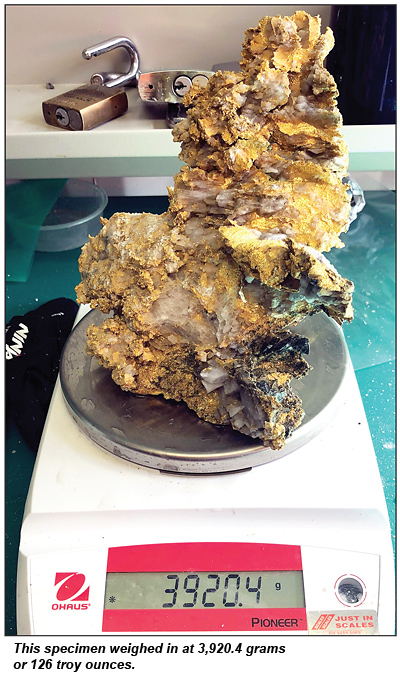 The Father’s Day Vein
The Father’s Day Vein
Henry Dole has been an airleg drill operator and blaster for sixteen years. He set off a blast that broke up an area of about 9’x9’ on Level 15. When he returned for his next shift on Father’s Day, there was “gold everywhere. There was chunks of gold in the face, on the ground; truly unique, I reckon. I nearly fell over looking at it. We were picking it up for hours.”
The discovery zone was initially fenced off and locked up. Armed security officers were brought in and additional surveillance set up as the large gold-quartz specimens were moved from the mine site to the Perth Mint. A few smaller pieces had fallen off a truck and were recovered from a gutter after the parking lot was cleaned and inspected.
Additional drilling continues, and another thirty feet of “high-grade coarse gold structure” was identified around the Father’s Day Vein. The initial discovery was an estimated 9,250 troy ounces gold, which included a gold-quartz specimen containing 2,400 ounces and another specimen containing 1,620 ounces.
On September 20, Royal Nickel revised the estimated number of ounces recovered thus far upward to 24,000 troy ounces. Additional gold-quartz specimens have been recovered, including one containing 1,100 troy ounces.
The mine produced 37,027 ounces in the entirety of 2017.
The company stated the updated estimate includes additional in-process material from the site of the blast, and coarse gold and gold-quartz specimens recovered from the expanded development area. All of the high-grade coarse gold is being processed by the Perth Mint, which has also reported more ounces than original estimates.
The company admittedly had been struggling a bit to keep the mine open prior to the discovery of the Father’s Day Vein. Their stock price fell from a high of US$0.68 per share in April 2014 and bottomed out at US$0.05 per share in August 2018. The company was in negotiations with a possible buyer. Although Royal Nickel is still considering a sale, the company will be considering other options after the latest developments. The price per share is currently US$0.43 at press time.
“We’re going to look at all the alternatives in terms of whether we look to raise capital at the mine level, whether we look at spinning it out publicly, whether we look at joint venturing with another mining company—this allows all options to be on the table for us,” said Royal Nickel CEO Mark Selby.
Initial plans are to auction off many of the specimens later in the year, after the company has a chance to exhibit them.
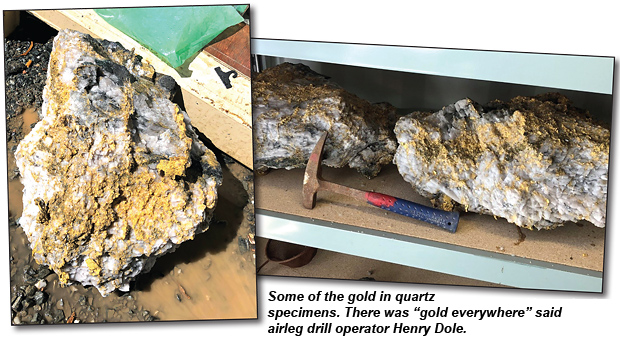 “We’ll be taking them around the world and as we’re doing that we’ll be hosting investor functions and collector functions, that whole promotion part of it and highlighting what a tremendous discovery it is,” said Selby in an interview with The West Australian.
“We’ll be taking them around the world and as we’re doing that we’ll be hosting investor functions and collector functions, that whole promotion part of it and highlighting what a tremendous discovery it is,” said Selby in an interview with The West Australian.
_______________
A video clip showing additional gold quartz specimens, courtesy ABC News Australia, is available online in the Videos section on our website at www.icmj.com 
The Miner’s Switchback
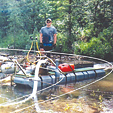 Common thought is the switchback slows the velocity of the rushing water and gold drops out from the cut bank to a fill gravel bar within or below the switchback. I am not going to disregard that model; however, I hope to improve upon it.
Common thought is the switchback slows the velocity of the rushing water and gold drops out from the cut bank to a fill gravel bar within or below the switchback. I am not going to disregard that model; however, I hope to improve upon it.
The “Chuck It Out” Nugget
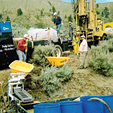 This was no ordinary nugget. It had not traveled very far from its nearby source, and that did mean a lot, as we were searching for the source of several such nuggets found during a gold rush that occurred in 1859.
This was no ordinary nugget. It had not traveled very far from its nearby source, and that did mean a lot, as we were searching for the source of several such nuggets found during a gold rush that occurred in 1859.
Wyoming's Billion Dollar Nugget—The Trilogy Ends
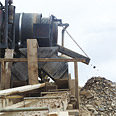 The next hurdle to jump was whether the trommel motor would start again after sitting on the desert for six years without being started. The last time it had taken a three foot pipe wrench to bust it loose.
The next hurdle to jump was whether the trommel motor would start again after sitting on the desert for six years without being started. The last time it had taken a three foot pipe wrench to bust it loose.
Mining Company Pays Millions for Gold Dug From Mine Dumps
Through a program that began in 2011, Barrick Gold Corp.-owned Golden Sunlight has paid out more than $45 million to small miners in the last seven years...
Gary It's There
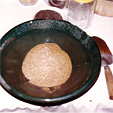 This year was a test. We had never done anything like this before, yet we grossed $30,000 in the short time we had to mine.
This year was a test. We had never done anything like this before, yet we grossed $30,000 in the short time we had to mine.
Hard Rock 101: Small-Scale Blasting
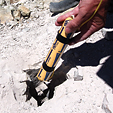 …the process remains much the same: Drill holes, load explosives, close up the holes, blast and muck out the resulting broken rock.
…the process remains much the same: Drill holes, load explosives, close up the holes, blast and muck out the resulting broken rock.
A Father’s Day to Remember: 24,000 Ounces Gold in Quartz
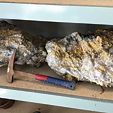 Father’s Day in Australia was on September 2, and it’s a day a group of miners from “down under” won’t soon forget.
Father’s Day in Australia was on September 2, and it’s a day a group of miners from “down under” won’t soon forget.
Subscription Required:
Free:
The Bawl Mill
• Legislative and Regulatory Update
• Ask The Experts - A few questions about 'peak gold'
• Ask The Experts - Seeking advice on processing pocket gold
• Ask The Experts - How do I recover gold in pyrite?
• Ask The Experts - Can a British citizen purchase a mining claim?
• Ask The Experts - Is California dredging going to return in 2019?
• Ask The Experts - Were you aware of the new recording fee in California?
• The Unusual Forest Nugget Patch
• California Sniping
• Large Gold Deposit Types
• PLP Update
• How to Beat the Heat--and The Bedrock
• Gold Prospecting: For Better or Worse--It Was A Dark and Overcast Night
• Using Geologic Publications to Discover Collecting Sites
• Prospector Unearths Huge 'Duck’s Foot' Nugget
• Melman on Gold & Silver
• Mining Stock Quotes and Mineral & Metal Prices








